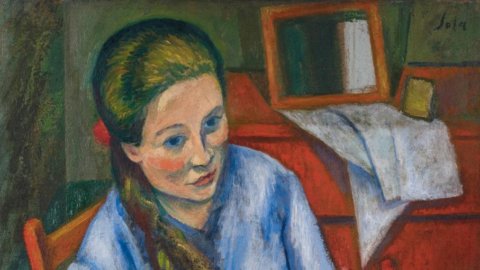After 17 days of opening and an average of 1900 daily admissions, the Modigliani, Soutine and the cursed artists exhibition at the Fondazione Roma Museum conquers the first place among the most visited exhibitions in the capital and the highest share of "likes" with the record of 32.000 visitors ” and positive comments registered in the exhibitions of recent years.
All the rooms are filled with visitors, amazed by the surprise of meeting Utrillo, Valadon and Soutine, but the flow of the public arrives in front of Modigliani's canvases and is enchanted by the illuminated female faces that emerge from the walls. At a time when violence against women is being fought, hers enchant and make us think. Without eyes - most of them - because Modì loved African art and therefore tribal faces, drawn with a clean and incisive stroke.
"His women were like this, because the corrupt human soul no longer has eyes to observe the world, while children are "worthy" of them, with blue eyes, mirror of the soul" says Marc Restellini, curator of the exhibition. his life - which lasted only 36 years - Modigliani created about 300 works, very few, today scattered all over the world, most of them in private collections.
The Rome-Palazzo Cipolla Foundation Museum hosts 14 of them, 9 of which portray his beautiful models, loved, known and painted. An unhappy and vital man at the same time, Modigliani was loved, often in spite of himself, by all the women in his life. Like Elvire, who was known in the circles as la Quique and who was the daughter of a prostitute from Marseilles. They met in early 1914 and it was love at first sight. She will not be the woman who will stay with him until his death, but only a flame, mentioned only twice in his portraits but which inspires many of his nudes, slender bodies and long necks like that of Elvire with white collar (1917-18). She, so beautiful that she is a singer and poses for the artists of Montmartre and Montparnasse, so beautiful that she can afford it. The perturbing gaze, black eyes, raven hair lives free in Modigliani's Paris, ending up in his arms with a tumultuous and painful, quarrelsome and sweet love until she disappears resuming her wanderings and ending up shot as a spy in Germany in the First World War. Alongside the Maiden in yellow dress (1917) and the Young seated woman with blue shirt (1919) paintings that have made their disarming normality their power: seated young people, simply dressed, with their hair tied back.
The sparse background, a living space made up of few things, just like the artist's studio must have been: two rooms, few pieces of furniture, faded walls. What fascinates about these canvases is the staid everyday life, which emerges in many works which – we learned later – were executed after a single session of the subject, because everything there was to observe and study Modì did beforehand.
Also on display is the Portrait of Béatrice Hastings, his first love: their relationship was punctuated by furious quarrels and great reconciliations. Modigliani loved her because she stood up to him, until, fed up with quarrels and beatings, she left him for a sculptor. Two works on display are dedicated to her true great love: The portrait of Jeanne Hébuterne and The red-haired girl. Of the numerous women who had entered and exited the life of the artist from Livorno, Jeanne was the last and most important, also as a model for his painting, portrayed in about twenty paintings and countless drawings. Born in Paris on April 16, 1898, the young woman embodied the ideal of feminine beauty for Modì: her hair with auburn reflections, her eyes of a very light blue, her nose straight, her complexion so white, almost diaphanous. She too painted, with talent , hiding an inner world so intense as to make her appear shy and reserved: she often remained silent and aloof, but observed carefully and chose. She did not miss that charming Italian painter, handsome, disputed, and male chauvinist. Barely eighteen she becomes his lover. Kicked out of the house and abandoned to her fate - above all by the hypocritical respectability of her mother - she will find her dimension in love and artistic creation right together with Modì and - in spite of the family - theirs will be a love forever.
The young woman entirely dedicated to her Amedeo, accepts his requests and limits, transforming him into her only horizon. She will forever close her big sad eyes the day after her partner's death, letting herself fall out of a window to follow her Amedeo. Her work that portrays her in profile with her hair gathered shows the womb of a woman pregnant with her: she was in fact portrayed two months before her suicide, when she was already expecting their second child.
All these works are without eyes, or the eye sockets are just hinted at. It seems that Modigliani could not paint a woman if he had not first loved her scrutinized inside her. Only then did the silent gaze find expression, only then did he know its soul. This is not true of the Girl in a Blue Dress (1918) whose pale blue eyes return the observer's gaze, pupils pointed outside the painting in search of the one who know how to recognize the sharpness of the soul.





